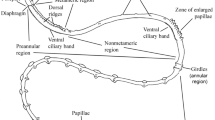Summary
Ototyphlonemertes pallida (Keferstein, 1862) has two statocysts, which are situated just behind the dorsal ganglions on the elongations of the ventral ganglions. Each statocyst consists of one statolith chamber cell, some nerve cells and a number of covering cells and is surrounded by a thick basement membrane. Usually the statolith chamber cell encloses three statolith chambers, which are intercommunicated and surrounded by a double membrane. Each chamber contains a single mobile statolith. Cilia and ciliary structures are lacking. Within the dorsal part of the statocyst some very ramified nerve cells are situated, which form a nerve fibre. In the vicinity of the statolith chamber cell the nerve cells split up into synaptical plates with electric synapses; there are one or several synaptical plates at the level of each chamber. The statolith chamber cell is surrounded by numerous covering cells, which are connected by desmosomes and additionally linked together at the outside in the ventral part of the statocyst. With regard to their structure the covering cells differ greatly from the other cell types, and they do not participate in impulse perception and impulse conduction. There do not exist any closer morphological relations to the statocysts lacking cilia in Coelenterates, Turbellaria, Holothuria, Xenoturbella and Tunicata. The statocyst of O. pallida represents an indigenous structure within the Nemerteans.
Zusammenfassung
Ototyphlonemertes pallida (Keferstein, 1862) hat zwei Statocysten, die unmittelbar hinter den Dorsalganglien auf den verlängerten Ventralganglien liegen. Jede Statocyste besteht aus einer Statolithenkammerzelle, mehreren Nervenzellen und einer Anzahl Hüllzellen und ist von einer dicken Basalmembran umgeben. Die Statolithenkammerzelle umschließt in der Regel drei Statolithenkammern, die von einer doppelten Membran umgeben sind und untereinander in Verbindung stehen. Sie enthalten je einen frei beweglichen Statolithen. Cilien und Ciliarstrukturen fehlen. Auf der Dorsalseite der Statocyste liegen mehrere stark verästelte Nervenzellen, die einen gemeinsamen Strang bilden. In der Nähe der Statolithenkammerzelle spalten sie sich auf und bilden pro Kammer eine oder mehrere synaptische Platten mit elektrischen Synapsen. Die Statolithenkammerzelle wird von zahlreichen Hüllzellen umgeben, die durch Desmosomen fest verbunden und zusätzlich in der ventralen Hälfte der Statocyste an den Außenseiten stark miteinander verzahnt sind. Die Hüllzellen unterscheiden sich im Aufbau deutlich von den beiden anderen Zelltypen und sind nicht an der Reizperzeption oder Reizleitung beteiligt. Zu den cilienlosen Statocysten bei Coelenteraten, Turbellarien, Holothurien, Xenoturbella und Tunicaten-Larven bestehen keine engeren morphologischen Beziehungen. Die Statocyste von O. pallida stellt eine Bildung sui generis innerhalb der Nemertinen dar.
Similar content being viewed by others
Abbreviations
- bm:
-
Basalmembran
- d:
-
Dendrit
- de:
-
Desmosom
- dg:
-
Dorsalganglion
- dm:
-
doppelte Membran der Statolithenkammer
- ds:
-
deltaförmige Strukturen
- ep:
-
Epidermis
- es:
-
elektrische Synapse
- hms:
-
Hautmuskelschlauch
- hz:
-
Hüllzelle
- k:
-
Zellkern
- m:
-
Mitochondrium
- ma:
-
abgewandeltes Mitochondrium
- mu:
-
Muskulatur
- n:
-
Nervenstrang
- nv:
-
Neurosekretvesikel
- nz:
-
Nervenzelle
- rs:
-
Rüsselscheide
- sc:
-
Statocyste
- sk:
-
Statolithenkammer
- skz:
-
Statolithenkammerzelle
- sp:
-
synaptische Platte
- st:
-
Statolith
- v:
-
Vakuole
- vg:
-
Ventralganglion
Literatur
Barber VC (1968) The structure of Mollusc statocysts, with particular reference to Cephalopods. Symp Zool Soc London 23:37–62
Budelmann BU (1976) Equilibrium receptor system in Molluscs. In: Mill PJ (ed) Structure and function of proprioceptors in the invertebrates. Chapman & Hall, London, pp 529–566
Budelmann BU (1978) The function of the equilibrium receptor systems of Cephalopods. Proceedings of The Neurootological And Equilibriometric Society, Vol. VI (1):15–63
Campbell RD (1972) Statocyst lacking cilia in the Coelenterate Corymorpha palma. Nature 238:49–51
Dilly N (1961) Electron microscope observations of the receptors in the sensory vesicle of the ascidian tadpole. Nature 191:786–787
Ferrero E (1973) A fine structural analysis of the statocyst in Turbellaria Acoela. Zool Scripta 2:5–16
Germer T, Hündgen M (1978) The biology of colonial hydroids. II. The morphology and ultrastructure of the medusa of Eirene viridula (Thecata-Leptomedusa: Campanulinidae). Marine Biology 50:81–95
Gerner L (1969) Nemertinen der Gattungen Cephalothrix und Ototyphlonemertes aus dem marinen Mesopsammal. Helgoländer Wiss Meeresunters 19:68–110
Geuze JJ (1968) Observations on the function and the structure of the statocysts of Lymnaea stagnalis (L.). Netherlands J Zool 18:155–204
Gibson R (1972) Nemerteans. Hutchinson, London
Horridge GA (1969) Statocysts of medusae and evolution of stereocilia. Tissue Cell 1:341–353
Horridge GA (1974) Recent studies on the Ctenophora. In: Lenhoff HM, Muscatine L (eds) Coelenterate Biology. Academic Press, London New York San Francisco, pp 439–468
Ivanov VP, Mamkaev YV, Pevzner RA (1972) Electron microscopic study of the statocyst of Convoluta convoluta, a turbellaria of the order Acoela. Zhurnal Evolyutsionnoi Biokhimii i Fiziologii, 8:189–193. Übersetzung: Consultants Bureau, New York (1973)
Kharkeevitch TA, Titova LK (1974) Electron microscope studies of the structural organisation of statocyst of Arenicola marina. Z Mikroskop-Anat Forsch 88:382–392
Kirsteuer E (1977) Remarks on taxonomy and geographic distribution of the genus Ototyphlonemertes Diesing (Nemertina, Monostilifera). Mikrofauna Meeresboden 61:167–181
Mock H (1978) Ototyphlonemertes pallida (Keferstein, 1862). Mikrofauna Meeresboden 67:1–14
Mock H, Schmidt P (1975) Interstitielle Fauna von Galapagos. XIII. Ototyphlonemertes Diesing (Nemertini, Hoplonemertini). Mikrofauna Meeresboden 51:1–40
Reisinger E (1960) Was ist Xenoturbella? Z Wiss Zool 164:188–198
Takahata M, Hisada M (1979) Functional polarisation of statocyst receptors in the crayfish Procambarus clarkii Girard. J Comp Physiol 130:201–207
Vinnikov YA (1969) Statocysts of Cephalopods. In: Bourne GH (ed) The structure and function of nervous tissue. Academic Press, London New York, pp 362–392
Author information
Authors and Affiliations
Rights and permissions
About this article
Cite this article
Brüggemann, J., Ehlers, U. Ultrastruktur der Statocyste von Ototyphlonemertes pallida (Keferstein, 1862) (Nemertini). Zoomorphology 97, 75–87 (1981). https://doi.org/10.1007/BF00310103
Received:
Issue Date:
DOI: https://doi.org/10.1007/BF00310103




